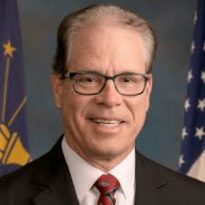USI falls to hot-shooting WIU, 87-62
USI falls to hot-shooting WIU, 87-62
MACOMB, Ill. – University of Southern Indiana Men’s Basketball fell to a hot-shooting Western Illinois University, 87-62, Thursday evening at Western Hall. The Screaming Eagles are 9-16 overall and 4-11 in OVC action, while the Leathernecks go to 9-17, 3-12 OVC.
USI jumped out to a quick 4-0 start, but WIU swiftly bounced back with a 12-4 dash to get control. The Leathernecks would extend the lead to as many as 17 points, 39-22, before an Eagles’ offensive surge cut the margin to single digits, 39-31, in the first half.
WIU scored the final six points of the first half to lead 45-31 at the break. Junior guard Damoni Harrison led the way for USI during the first 20 minutes with 13 points, while junior guard Jayland Randall added nine first-half points.
In the second half, USI was unable to get any momentum going as WIU continued its hot-shooting game. The Leathernecks extended its halftime margin to as many as 28 points (87-59) by shooting 62.1 percent in the final 20 minutes (18-29) and 56.7 percent for the game (34-60).
USI was led in the 87-62 loss by Harrison, who posted his second double-double of the year with 21 points and 10 rebounds. He was followed by Randall, who had 17 points, while sophomore forward Stephen Olowoniyi closed out the double-figure scorers with 10 points.
After the loss, the Eagles are three games out of the OVC post-season race. USI trails the University of Tennessee at Martin and Lindenwood University, who are tied for seventh in the league standings.
Next Up For USI:
The Lions of Lindenwood are 12-14 overall and 7-8 in the OVC after upsetting Morehead State University, 73-60, at home tonight. Lindenwood is 3-2 in the last five games and .500 over the last 10 contests.
The Eagles lead the all-time series, 8-1, after taking the first meeting of the year in January, 80-73. Harrison led three Eagles in double-digits with 26 points and 10 rebounds. He was followed by Randall, who had 17 points, and graduate forward Jack Mielke, who had 10 points.
UE women’s basketball earns second MVC win over Bradley
ANALYSIS: Exploring The Evansville DORA: Will it be like Austin, TX or Shawneetown, IL?
The Evansville City Council’s unanimous decision to establish a Designated Outdoor Refreshment Area (DORA) aims to invigorate the downtown area by permitting patrons to carry alcoholic beverages from participating establishments within a specified zone. As the city prepares to launch this initiative in April, with 22 restaurants and bars on board, it’s essential to consider the potential impacts on economic growth, crime rates, and livability, especially given the concerns of downtown’s predominantly older residents.
Economic Growth
Implementing a DORA can bolster the economic vitality of downtown areas. By allowing patrons to move freely with beverages, these zones can enhance the appeal of downtown districts, potentially increasing foot traffic and benefiting local businesses. For instance, a report from Ohio State University noted that DORAs could support the economic vitality of downtown areas, especially as they recover from the pandemic.
However, the success of a DORA in stimulating economic growth depends on various factors, including effective management, community engagement, and the unique characteristics of the area. It’s crucial to set realistic expectations and recognize that while a DORA can contribute to economic development, it is not a standalone solution. It will also create a need to hire more law enforcement officers to keep downtown Evansville from being a stomping ground for wandering drunks.
Crime and Safety
Concerns about increased crime, such as fistfights and robberies, in areas with relaxed open container laws are valid. However, evidence suggests that with proper planning and enforcement, DORAs do not necessarily lead to higher crime rates. For example, in Montgomery, Ohio, the police department conducts routine patrols and enforces responsible behavior within the DORA, ensuring that the boundaries are strictly maintained and that alcoholic beverages are not carried outside the designated area.
The key to maintaining safety is proactive management, including clear signage, designated patrols, and community involvement. By establishing and enforcing guidelines, Evansville can mitigate potential safety concerns associated with the DORA.
Livability and Community Impact
The introduction of a DORA can have mixed effects on livability, particularly in areas with a significant residential population. In Jasper, Indiana, discussions about implementing a DORA raised questions about its impact on downtown residents and future development.
For Evansville, where the downtown population is relatively small and has experienced slow growth, it’s essential to balance the interests of businesses and residents. Engaging with the community, particularly older residents, to address concerns such as noise, litter, and safety will be crucial. Implementing measures like restricted hours, designated consumption areas, and regular clean-up efforts can help maintain the quality of life for downtown inhabitants.
Conclusion
As Evansville moves forward with establishing its DORA, the city can look to the experiences of other communities to anticipate potential outcomes. While DORAs offer opportunities for economic enhancement and increased vibrancy, they also require careful planning and management to address concerns related to crime and livability. By proactively engaging with residents, enforcing regulations, and fostering collaboration between businesses and law enforcement, Evansville can work towards creating a DORA that benefits the downtown residential community.
FOOTNOTE: This article was posted by the CCO without bias, opinion, or editing.
Love—and then some health-care legislation—was in the air in the Indiana House

In a place where there can be no love lost, Rep. Vernon G. Smith, D-Gary, took a moment to celebrate love by distributing Valentine’s Day stuffed animals to legislators on both sides of the aisle.
But after the pink bears and bandana-wearing dogs were happily displayed on desks, it was back to business as usual.
A number of bills read in the House on Thursday would impact Hoosier health care, with a common theme being accessibility and affordability.
House Bill 1024 received bipartisan support and will continue to the Senate, sponsored by Sens. Rick Niemeyer, R-Lowell, and Mike Bohacek, R-Michigan Shores. The author, Rep. Harold Slager, R-Shererville, explained that the bill would continue Medicaid reimbursement for some children’s hospitals in neighboring states.
“This is a really popular program, and interestingly, the cost is not that high,” said Slager.
Rep. Earl L. Harris Jr., D-East Chicago, was one of the members who spoke in support of the bill. He shared a personal anecdote of a young cousin who had to come from Northwest Indiana to Indianapolis to receive proper medical care. This was before the law, which would have allowed the child to visit a closer hospital in Chicago.
“This has been a great move,” said Harris. The bill passed with 91 yea votes and zero nays.
House Bill 1555 aims to expand health-care accessibility for Hoosiers by allowing limited medical licensure to those who were trained internationally. The providers would need to meet certain criteria, and after five years of practice, the board may choose to provide them an unlimited license.
“House Bill 1555 is an important step towards addressing two critical challenges in our health care system: rising costs and the ongoing shortage of medical professionals, particularly in rural and underserved communities,” Rep. Beau Baird, R-Greencastle, the bill’s author, said.
The bill received 91 yeas and one nay from Rep. Ryan Dvorak, D-South Bend. It will be sponsored in the Senate by Sens. Liz Brown, R-Fort Wayne, Jean Leising, R-Oldenburg, Susan Glick, R-LaGrange and Sen. Andrea Hunley, D-Indianapolis.
House Bill 1666 by Rep. Julie McGuire, R-Indianapolis, would require more transparency from health-care providers in relation to ownership. It would require a merger review through a board, which would approve or deny merger requests. This process would have a 90-day limit.
“Patients, providers and the public need to trust that health-care decisions are made based on the best interest of the patient, rather than hidden financial motives,” said McGuire.
Rep. Maureen Baur, D-South Bend, spoke in opposition to the bill, raising concerns about specific measures it has outlined.
“While transparency in health care is essential, this bill introduced some measures that could have unintended and detrimental consequences for our state’s health-care system,” said Baur. She highlighted smaller and specialty health-care providers as particularly vulnerable to the review process and the burden it may place on them.
Rep. DeLaney, D-Indianapolis, also spoke in opposition to the bill.
“I understand that there’s a real desire to deal with medical costs. We have bill after bill, year after year, to deal with it. My belief is, we do not have, as a state, the economic, political, legal power to effectively touch that market,” said DeLaney.
Rep. Ben Smaltz, R-Auburn, is one of the co-authors on the bill.
“We want to discover conflicts of interest,” he said of the bill’s intentions. “If a merger doesn’t get approved, there’s a reason for that.”
The bill passed with 70 yeas and 25 nays. Senate sponsors are Sens. Tyler Johnson, R-Leo, Chris Garten, R-Scottsburg, and Ed Charbonneau, R-Valparaiso.
STATEMENT: Gov. Braun collaborates on Avian Flu effort in Indiana
INDIANAPOLIS – Governor Mike Braun issued the following statement regarding Avian Flu monitoring in Indiana.
“Hoosiers can rest assured that state government is monitoring the Avian Flu situation. At my direction, there is regular collaboration between the Indiana Board of Animal Health (BOAH), Indiana Department of Agriculture, Indiana Department of Natural Resources (DNR), and Indiana Department of Health (IDOH) and I receive regular interagency briefings.
“The Indiana Department of Agriculture, working with the Board of Animal Health, is engaging with poultry producers, whether large scale or hobby farms, to ensure close communication and cooperation. DNR is monitoring the situation as it impacts recreation, hunting, and sports. IDOH is responsible for monitoring potential human exposure to the Avian Flu. I am grateful for the cooperation and leadership of Lt. Gov. Micah Beckwith; Cabinet Secretary Suzie Jaworowski, Office of Energy and Natural Resources; and Cabinet Secretary Gloria Sachdev, Office of Health and Family Services, as they coordinate these efforts.”
While the health risk to the public is classified as low, Hoosiers and poultry owners who notice sick or dead birds should not touch the bird and instead contact their veterinarian or the Healthy Birds Hotline, 866-536-7593.
OPINION: Will This Be the Year That Indiana Legalizes Weed?
The Debate on Marijuana Legalization in Indiana: Pros and Cons
By Johnny Kincaid
FEBRUARY 14, 2025
Once again, the Indiana legislature is debating whether or not to make marijuana possession and use in the state.
Whenever the topic comes up, I flashback to my senior year in high school. It was 1975, and, yes, I inhaled… A LOT! Drug use among high school students was the highest during the mid-70s. I never thought that the momentum for legalization would ever reach current levels.
With neighboring states embracing cannabis reform, the debate over whether to legalize marijuana within our borders has intensified. There are compelling arguments on both sides of this issue, so it is essential to weigh both the potential benefits and drawbacks.
The Case for Legalization
Economic Growth and Tax Revenue: Legalizing marijuana could significantly boost Indiana’s economy. States like Colorado and Illinois have generated millions in tax revenue from cannabis sales, which funds education, infrastructure, and public health programs.
Criminal Justice Reform: As a prison ministry volunteer, I have met many guys doing fairly long stretches for possession. While I hate seeing a guy taking time to get high, I still am not ready for legalization.
Medical Benefits: For the past 50 years there have been claims of the medicinal benefits of pot, alleviating chronic pain, anxiety, epilepsy, and other medical conditions. Is THC medicine or not?
The Case Against Legalization
Public Safety Concerns: Opponents worry that legalization could lead to an increase in impaired driving incidents and workplace accidents. THC (the active ingredient in pot) is fat soluble instead of water soluble, so instead of quickly being flushed from the body like alcohol and other drugs, THC can linger in the system for up to six weeks. For this reason, law enforcement agencies struggle to establish accurate roadside impairment tests for marijuana use.
Health Risks: While marijuana has medicinal properties, excessive use can have negative effects, including cognitive impairment, addiction, and mental health issues. Some medical professionals caution that legalization could lead to increased use, particularly among young people, whose developing brains may be more vulnerable to long-term effects.
Regulatory Challenges: Establishing a legal cannabis market requires comprehensive regulation and oversight to prevent illicit market activity, ensure product safety, and address potential workplace policies regarding employee use. Indiana would need to develop a robust regulatory framework to manage the industry effectively.
Finding Common Ground
The decision to legalize marijuana in Indiana is complex and multifaceted. While legalization offers potential economic and social benefits, concerns about safety, health, and regulation cannot be ignored.
FOOTNOTE: This article was posted by the CCO without opinion, bias or editing.
Indiana Chapter of the National Tooling and Machining Association Competition at Vincennes University
Indiana Chapter of the National Tooling and Machining Association (INTMA) High School Machining Competition at Vincennes University.
The competition will bring together around 90 students from nearly a dozen high schools across Indiana. They will compete in rigorous machining challenges that highlight the essential skills driving today’s modern manufacturing industry.
Competitors will showcase their skill sets in CNC technology through programming and milling competitions. Participants will also engage in precision exercises in manual machining, including manual milling, manual lathe work, and surface grinding – skills that are foundational to manufacturing.
An employer fair will also take place.
WHEN:
Saturday, Feb. 22, 2025
8 a.m.-noon (ET)
WHERE:
Vincennes University Technology Center
- HURCO Center, Room A116 and A118
- Manual Machining Lab, Room 100
1300 N. Chestnut St.
Vincennes, Indiana
47591











